|
Getting your Trinity Audio player ready...
|
A ‘solution’ of governments and industry to the common practice of burning off methane pollution and other air pollutants at oil and gas facilities is seemingly less efficient than claimed. The result is continued pollution and potential harm. Where there’s drilling, there’s fire…but, also, sometimes, just gushing pollution.
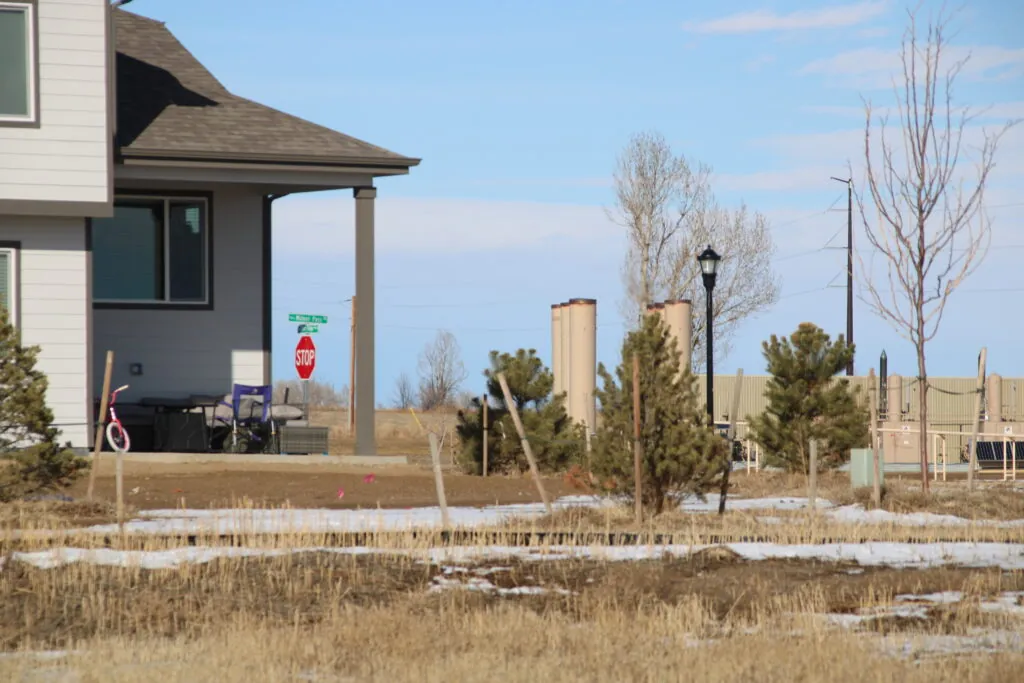
Picture this: you move into a home in Northern Colorado, much like the one pictured above, lured to the state by work or by the promise of outdoor fun and mountain vistas. First, you discover that those fabled mountain views are sometimes obscured by a thick haze, which you learn is really harmful smog, for weeks on end. Smog forms when pollutants such as volatile organic compounds (VOCs) are released from oil and gas facilities. Cities in Colorado such as Denver and Fort Collins rank among the worst in the USA for air quality because of smog’s prevalence in the region.
Then, you start to pay more attention to the oil and gas well pad in your neighborhood. Living next to this facility did not bother you too much at first, as you never observed any flames or pollution from the equipment on the facility. Plus, you read that Colorado banned routine venting and flaring at oil and gas facilities in order to protect people like you from air pollution. But, the more you look at the large cylinders on the well pad, the more you notice ripples of heat, like you see from pavement on hot days, emerging from the openings at the top. You wonder: “What have I been missing?”
The answer, unfortunately, is that you are living next to a facility where flaring occurs in equipment known as enclosed combustion devices (ECDs). This flaring can have negative impacts on both local air quality and the climate.
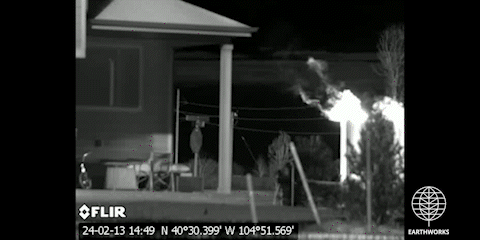
What is Flaring?
Flaring is the process of burning methane gas, a potent greenhouse gas, and other harmful VOCs, at oil and gas facilities to “destroy” these compounds rather than release them directly into the atmosphere. “Destroying” in this case is a misnomer, as it really means converting it into another greenhouse gas, carbon dioxide. This process is not perfect, meaning that some methane and VOCs still escape to the atmosphere.
More on that later…
“Routine flaring,” which has been banned by states like Colorado and countries like Colombia and has been ordered to be phased out in other countries such as Ecuador, is the practice of burning methane gas produced along with oil that an operator is not capturing to sell.
Oftentimes, even though methane gas is a product with a market value, it is cheaper and more convenient for an operator (especially in remote regions like the Ecuadorian Amazon) to simply burn it. But what is convenient for an operator is often harmful for communities, as they suffer the consequences of the pollution from routine flaring. This is why governments around the world are passing laws and rules to prohibit this practice.

However, even after routine flaring is prohibited, many facilities in places like Colorado still flare during drilling and fracking, and in the case of maintenance activities or emergencies. It is also done to destroy methane gas and other VOCs from other polluting equipment like storage tanks, where these gases evaporate off of the crude oil and wastewater. This is especially true of large facilities associated with the transmission and refining of oil and gas such as compressor stations and gas plants, where flares are used to burn off excess gases and therefore “control” pollution.
In other words, wherever there is oil and gas activity, there is likely to be flaring, even if “routine flaring” is prohibited.
Pollution from Flares
Whether routine or not, flaring traditionally occurs in elevated flares. These are tall stacks where the combustion process occurs at the top and is exposed, meaning there are often visible flames. The flames from these flares are a source of concern for community members who live near facilities and are a constant reminder of the impact oil and gas activities have on their health, their neighborhoods, and the climate.
This design also means that the flame is exposed to the elements, and it is not uncommon for these types of flares to be inefficient at burning methane gas and other VOCs, or for the flare to become unlit. In both cases, the flare ends up releasing gases to the atmosphere that it should be burning.
When we look at an inefficient, elevated flare with one of our OGI cameras (which are designed to visualize hydrocarbon compounds like methane and other VOCs that are otherwise invisible to the naked eye), we can see the pollutants that are not being destroyed by that flare and are instead being released into the atmosphere.
Here is an example from Colorado:


And from New Mexico:

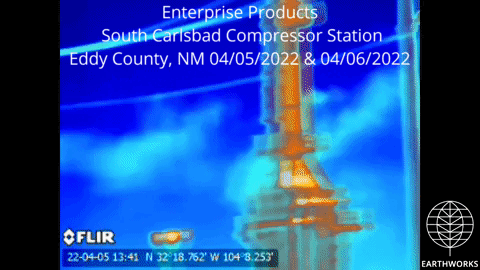
Enclosed Combustion Devices as a More “Efficient” Solution
Recently, in states like Colorado and New Mexico, as well as in the Ecuadorian Amazon, the oil and gas industry has been replacing traditional, elevated flares with enclosed flares or enclosed combustion devices (ECDs). These flares enclose the flame to protect it from the elements, and therefore theoretically allow for greater control and more efficient burns. The presumption, based primarily on manufacturer’s technical documents, is that ECDs are oftentimes 95-98% efficient, meaning they burn 95-98% of the methane gas and other VOC compounds routed to them and only a small percentage of the total gas escapes to the atmosphere. But, very little independent testing has been done to ensure that ECDs are as efficient as manufacturers or operators claim.
ECDs also conveniently hide most visible evidence of flames or combustion from community members, many of whom therefore do not always recognize that ECDs are actually flares.
When adoption of ECDs coincides with a heavily publicized ban on routine flaring such as in Colorado, or with a court decision to eliminate flaring in close proximity to vulnerable communities such as in Ecuador (en español), it becomes much easier to convince the public that flaring has been curbed or eliminated entirely. And with flaring “visibly” eliminated, oil and gas operators can more easily present themselves as having addressed some of the health and climate impacts associated with their industry.

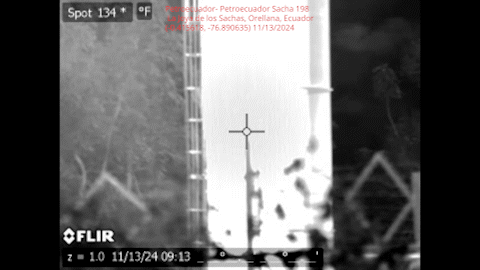
The truth is not so convenient.
Years of evidence gathered using our OGI cameras to observe emissions from ECDs in states like Colorado demonstrates that concerning pollution due to inefficient combustion in ECDs is a common occurrence. In Colorado, we documented 352 emissions events at oil and gas facilities from 2022-2024. Of those 352 events, 98 were pollution from inefficient ECDs.
More troubling is that the presumption that ECDs are efficient is oftentimes referenced by operators to refute our evidence of pollution. They rarely provide data to actually demonstrate that the equipment is as efficient as advertised. They merely claim it is, while claiming that our evidence is therefore nothing to worry about.
You decide for yourself:


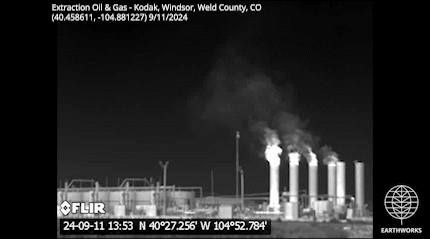
If these videos of pollution seem remarkably similar to the videos of pollution from the inefficient, traditional flares that were shared above, that is because they are.
It is important to note however that we cannot use these videos to claim that these ECDs are not 95-98% efficient because videos of pollution alone cannot tell us how much pollution is actually occurring. But for that exact same reason, operators cannot refute these videos by simply stating the ECDs are operating efficiently.
The Truth about Flaring
Whether flaring is occurring as a result of routine flaring or as a result of a maintenance activity, it is a source of pollution.
Whether flaring is occurring in a traditional, elevated flare, or an ECD, there is commonly pollution associated with inefficient combustion.
Wherever oil and gas activity exists, flaring is likely to exist for one reason or another, even if the flames are hidden from plain sight.
The oil and gas industry still spends as much – if not more – time downplaying or concealing their polluting activities than actually addressing them. We are going to continue to make sure they do not get away with it.

